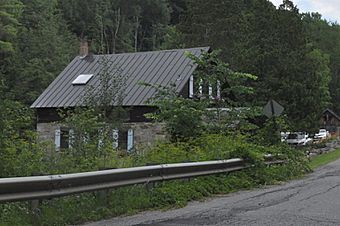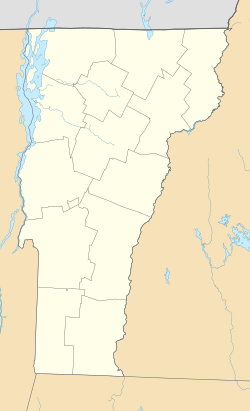Hoag Gristmill and Knight House Complex facts for kids
Quick facts for kids |
|
|
Hoag Gristmill and Knight House Complex
|
|

The former Hoag Gristmill
|
|
| Location | State Prison Hollow Rd., Starksboro, Vermont |
|---|---|
| Area | 7.7 acres (3.1 ha) |
| Built | 1799 |
| Architectural style | Greek Revival, Federal |
| NRHP reference No. | 80000325 |
| Added to NRHP | April 22, 1980 |
Imagine stepping back in time to see how people lived and worked long ago! The Hoag Gristmill and Knight House Complex is a special historical place in Starksboro, Vermont. It used to be a busy industrial area, with buildings dating all the way back to the 1790s. This complex, which includes an old mill and a house from the 1820s, helps us remember the early days of industry in Starksboro. Because of its importance, it was added to the National Register of Historic Places in 1980.
Contents
Exploring the Historic Hoag Gristmill
The Hoag Gristmill and Knight House are located in a beautiful valley. This valley was carved out by Lewis Creek in the countryside of Starksboro. The old mill building stands very close to the north side of State Prison Hollow Road. It is built on a strong, two-story stone base. This base sits between the road and the creek.
The Mill's Story
The top part of the mill is made of wood with a sloped roof. This part was rebuilt in 1896 after a fire. The stone base is much older, dating back to the 1790s. This is when the first gristmill was built here. A gristmill is a place where grain, like wheat or corn, is ground into flour.
Who Built the Mill?
The first mill was started by Joseph Hoag. He was an important leader of the Quakers in the area. Quakers are a religious group known for their simple lifestyle and peaceful beliefs. Other parts of the original mill, like a dam and a penstock, are now gone. A penstock is a pipe or channel that carries water to power a mill. Floods have washed these parts away over time. Today, the old mill building is used as a home.
Discovering the Knight House
Also on the north side of State Prison Hollow Road is the Knight House. It is located across Lewis Creek and to the east of the mill. This house was built in the 1820s.
Features of the Knight House
The main part of the house is a traditional five-bay Cape style. This means it has five windows or doors across the front. It also has smaller, one-and-a-half-story sections attached to its northern end. One special part of the house is its front door. It has four panels and a unique, handmade door handle. Above the door, there is a half-circle window.
Inside the Knight House
Inside, the house has simple but beautiful wooden details. These details are in the Greek Revival style. This style was popular in the early 1800s and was inspired by ancient Greek buildings. The first known owner of the house was Benjamin Knight. He ran a carding mill nearby. A carding mill was a place where wool was prepared for spinning into yarn. For a while, the Knight House was owned by the same family who ran the Hoag Gristmill. Both the mill and the house were carefully repaired and restored in the mid-1900s.



